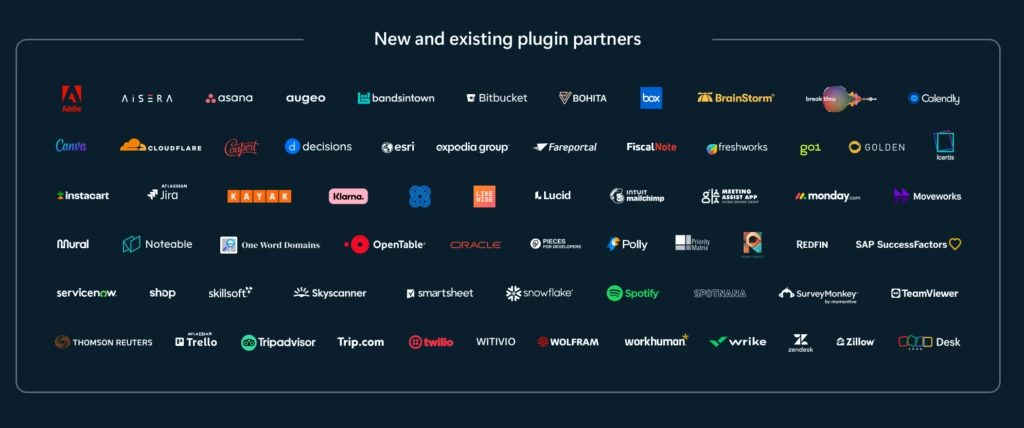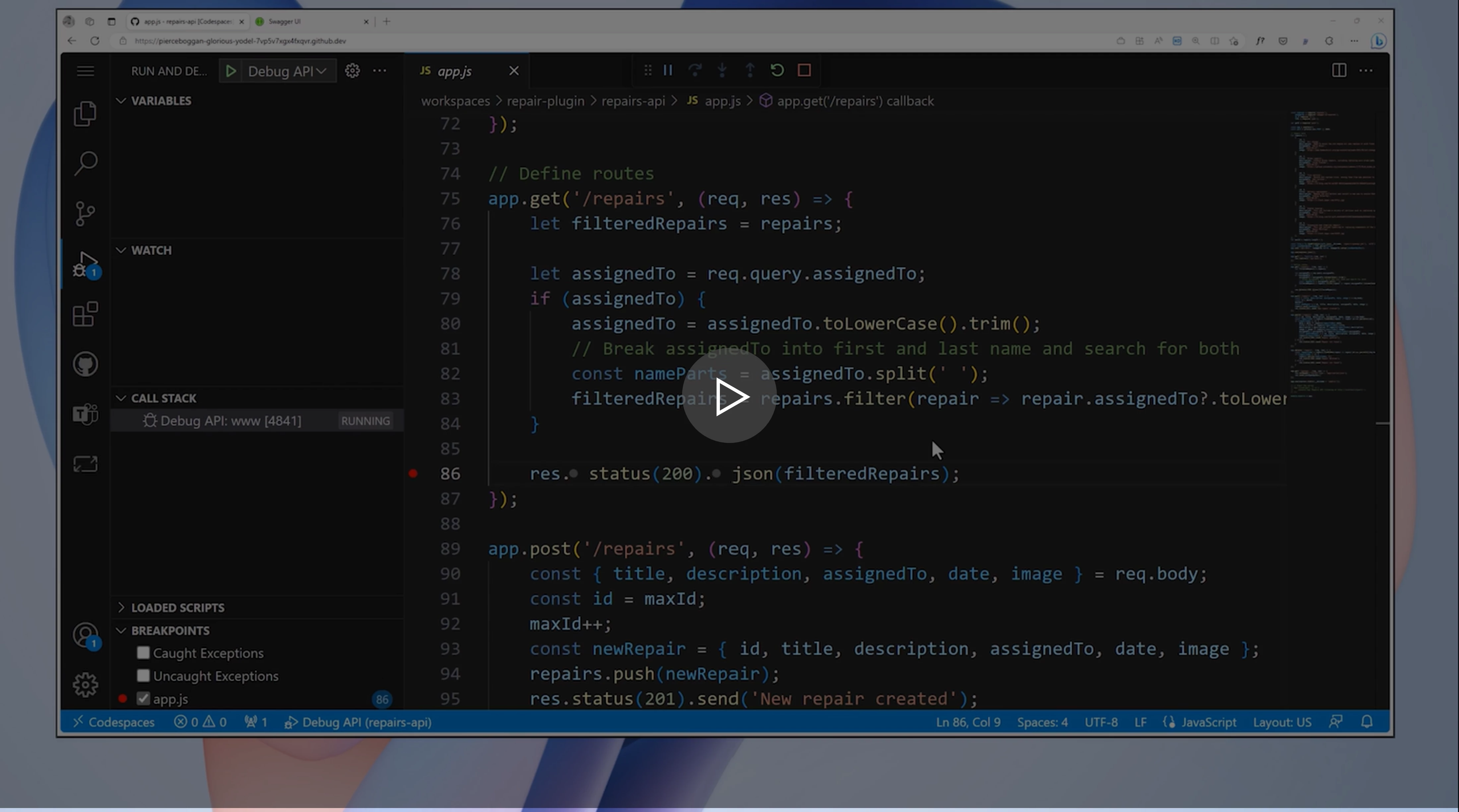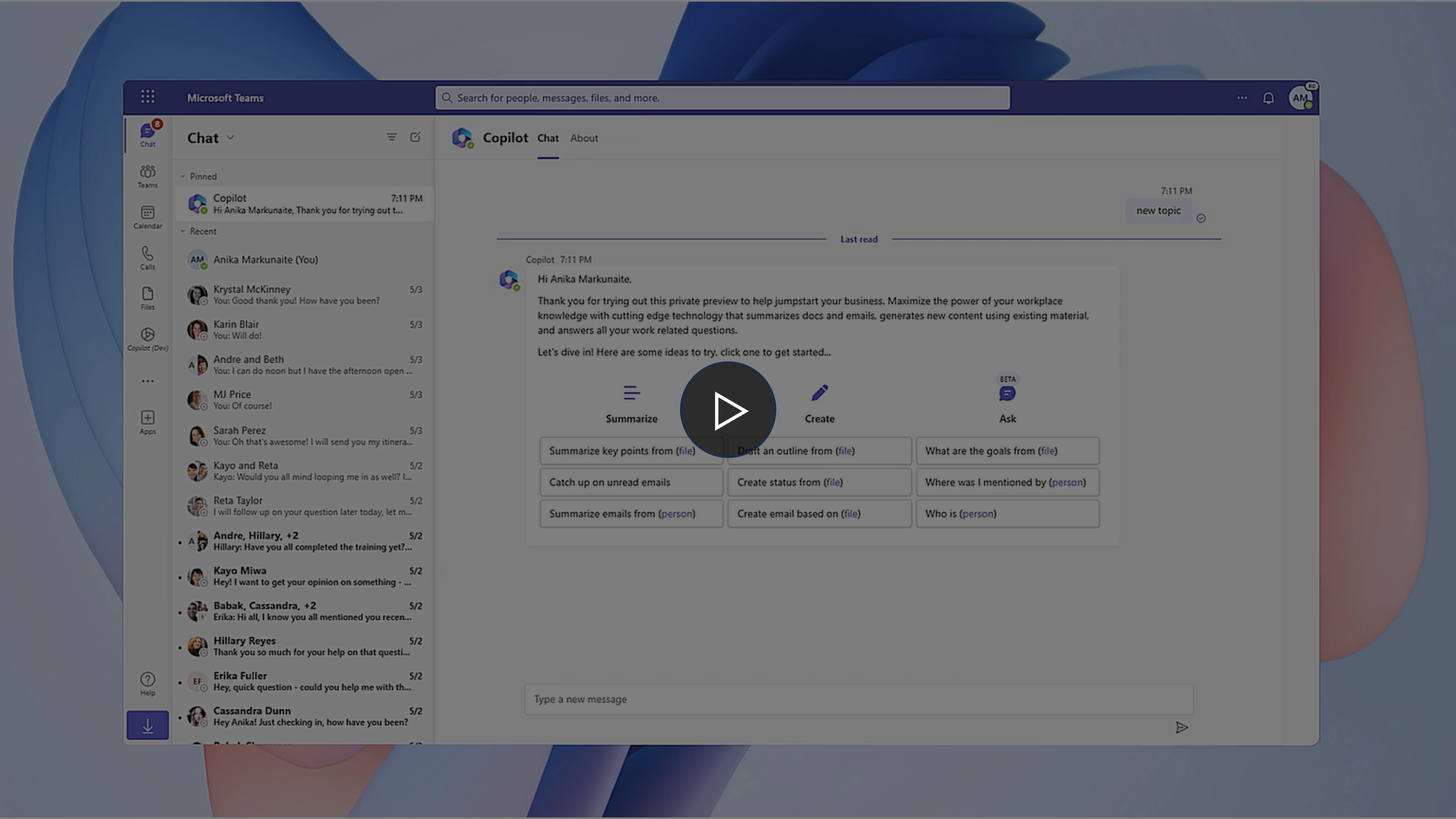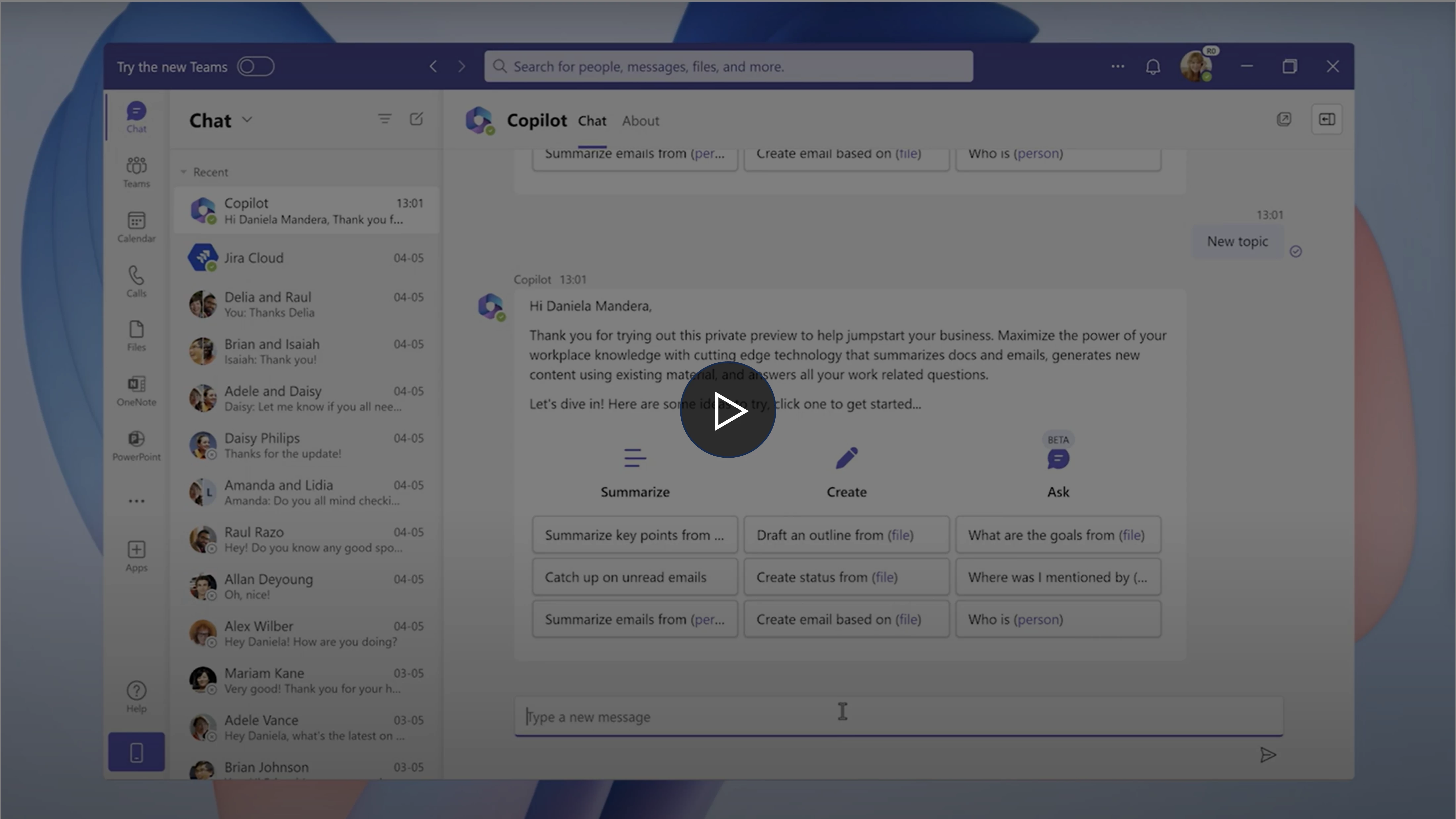
Empowering every developer with plugins for Copilot for Microsoft 365
Generative AI models are ushering in the next frontier in interactions between humans and computers. Just like graphical user interfaces brought computing within reach of hundreds of millions of people three decades ago, next-generation AI will take it even further, making technology more accessible through the most universal interface—natural language.
Microsoft’s approach to generative AI is focused on keeping humans at the center and augmenting human agency. It’s not an autopilot approach, but rather a design ethos that we call Copilot to tackle the growing volume of digital debt that is taking attention away from innovation and sapping our productivity. According to Microsoft’s latest Work Trend Index research, the inflow of data, emails, meetings, and notifications has outpaced our ability to process it all. Workers are spending two full days of the work week managing email and attending meetings—just to keep up. While 49 percent of people said they’re worried that AI will replace their jobs, even more—70 percent—would delegate as much work as possible to AI to lessen their workloads.
Today, I’m excited to announce extensibility for Copilot for Microsoft 365 with plugins. With this announcement, we’re empowering every developer to integrate their apps and services into Copilot for Microsoft 365. Together, we can reach hundreds of millions of people where they work every day to create a whole new way of work.
Copilot for Microsoft 365: Your copilot for work
Earlier in March, we announced Copilot for Microsoft 365 which brings the power of next-generation AI to Microsoft 365 products like Microsoft Teams, Outlook, and more. Microsoft 365 products are among the leading productivity, communications, and collaboration solutions in the market today.
Copilot for Microsoft 365 combines the power of foundation models with your data in Microsoft Graph and Microsoft 365 apps to turn your words into the most powerful productivity tool on the planet. You experience Copilot for Microsoft 365 in two ways: in-app assistance and cross-app intelligence to unleash creativity, unlock productivity, and uplevel skills.
The success of our products, like Teams, with more than 300 million active users, would not be possible without our vibrant community of developers and partners. You’ve been a key part of this journey, building the ecosystem with us, with apps that run on and extend our products. As I look at this next-generation AI opportunity, I’m most excited about what we can do together.
Plugins for Copilot for Microsoft 365
Copilot in Bing
Learn moreAt Microsoft Build 2023 today, we’re announcing a joint commitment from Microsoft and OpenAI to support and grow the AI plugins ecosystem. We are embracing an open standard for plugins that integrates across OpenAI’s ChatGPT and Microsoft Copilot.
Copilot in Windows
Read about itToday, we’re announcing the extensibility model for Copilot for Microsoft 365 with plugins. Developers can now integrate their apps and services into Copilot for Microsoft 365 with plugins to reach hundreds of millions of people where they work every day. Plugins are tools that augment the capabilities of AI systems, enabling them to interact with APIs from other software and services to retrieve real-time information, incorporate company and other business data, and perform new types of computations.
There are three types of plugins for Copilot for Microsoft 365: ChatGPT plugins, Teams message extensions, and Microsoft Power Platform connectors—enabling developers to use existing software and tooling investments and skills.

Customers in the Copilot for Microsoft 365 Early Access Program will have access to more than 50 plugins from partners including Atlassian, Adobe, ServiceNow, Thomson Reuters, Moveworks, and Mural. Thousands of additional line-of-business and third-party plugins will be enabled in the coming months as we integrate existing Teams message extensions and Microsoft Power Platform connectors with Copilot for Microsoft 365. This extensive ecosystem of plugins for Copilot for Microsoft 365 surfaced in the tools used every day for work will bring unprecedented value to our mutual customers as we transform how work gets done together.

With Teams Toolkit for Visual Studio, Visual Studio Code, and CLI, developers can create Teams message extensions today that will function as plugins for Copilot for Microsoft 365. We are introducing new capabilities in Teams Toolkit to make it easy to create, test, and debug plugins. Developers can bring any API described by the OpenAPI specification to Copilot for Microsoft 365 quickly with the plugin creation experience in Teams Toolkit, available in private preview today.
Developers can control and customize the user experience when their plugin is invoked through Adaptive Cards. Based on the metadata in the OpenAPI specification, Teams Toolkit scaffolds a plugin containing a manifest and declarative Adaptive Cards that define the Copilot user experience. Developers can further customize the manifest and cards to fit their scenario, such as configuring authentication settings, before testing their plugin in Copilot.
See the new tooling in action below, and sign up for the developer early access program to try it out.

Supercharge your data with Semantic Index for Copilot
Microsoft Graph is the gateway to customers’ productivity and collaboration data, as well as their compliance, security, and privacy policies. Copilot grounds the user prompts and responses with the Microsoft Graph data and inherits security and permissions at runtime. This enables an approach to security and governance that our customers control. Furthermore, the data stays in the customers’ tenant and is not used for training Microsoft’s foundation Models.
Microsoft Graph Connectors are Generally Available
Learn moreThe recently announced Semantic Index for Copilot is a sophisticated map of user and company data and powers how Microsoft Graph data is surfaced to Copilot. It computes vector embeddings from Microsoft Graph data to capture semantics and similarities around content and users and enables fast semantic search by Copilot across billions of items in a vector index. Developers can bring their data to Microsoft Graph with Graph connectors to take advantage of the Semantic Index for Copilot to deliver more personalized and actionable responses.
In addition to productivity and collaboration data in Microsoft Graph, Copilot for Microsoft 365 can now also access structured data from Microsoft Dynamics 365 and Microsoft Power Platform stored in Microsoft Dataverse. This means copilot responses will be grounded in your business data in addition to user data in Microsoft Graph. Customers in the Copilot for Microsoft 365 Early Access Program will be able to try out this capability as we roll out Copilot for Microsoft 365 in the program. Developers can import data into Dataverse through Microsoft Power Platform connectors. Watch a demo below of what’s possible with access to business data in Dataverse. Read this blog to learn more.

Copilot for Microsoft 365 extensibility in action
Developers will play a vital role in defining new patterns of work as users experience Copilot for Microsoft 365 with their integrated apps and services. The demo below shows the simulated scenario of a user at Dentsu Inc., an integrated marketing solutions and agency service company, harnessing the power of Copilot for Microsoft 365 together with a plugin for Atlassian’s Jira, a line-of-business Dentsu app plugin for sourcing media assets, and data from Atlassian’s Confluence integrated using a Microsoft Graph connector. Copilot for Microsoft 365 used Teams message extensions for Jira and Dentsu’s line-of-business app—no new code was written. You can see the full demo here:

Accelerating success for every developer
With the new extensibility model for Copilot for Microsoft 365 with plugins, we are enabling developers to easily participate in the AI opportunity and reach hundreds of millions of Microsoft 365 users, using their existing expertise, code, and tools. Microsoft is committed to ensuring your success across the entire app life cycle. That’s why we are bootstrapping extensibility for Copilot for Microsoft 365 by grounding it with the Teams and Microsoft 365 platform and programs. Developers extending Copilot for Microsoft 365 will benefit from tooling, distribution, management, commerce, and enterprise readiness of the Teams and Microsoft 365 platform.
Our goal is to maximize developer productivity, app reach, app discovery, and revenue. Developers with existing Teams message extensions will not have to write new code to extend Copilot for Microsoft 365, and developers can easily create new plugins with Teams Toolkit for Visual Studio. Plugins can be configured, published, and managed in the Developer Portal for Teams. Developers can take advantage of the App Compliance Automation Tool and Microsoft 365 App Compliance Program to speed up IT approvals and reach more users. To increase user discovery, developers can take advantage of platform capabilities like link unfurling and contextual app exposure in surfaces such as chat, channels, and meetings in Teams. Finally, our commercial marketplace enables developers to monetize their plugins.
Learn more about Copilot for Microsoft 365
We are excited for this opportunity we have together with developers and partners to shape the future of work with AI. Copilot for Microsoft 365 is entering the Early Access Program and customers will soon be able to try the extensibility we are announcing at Microsoft Build. Here’s what developers and partners can do today to get ready for Copilot:
- Build a Teams message extension to get your plugin for Copilot for Microsoft 365.
- Build a Microsoft Graph connector and bring your data into Semantic Index for Copilot.
- Sign up for the developer early access program to build plugins for Copilot for Microsoft 365.
Access all the resources and tools mentioned above.
More innovations to build apps
We have many exciting announcements beyond Copilot extensibility that help you build apps for all the new ways to work. Here are a few highlights.
Live Share SDK
Now generally availableEffective collaboration and cocreation can be challenging in hybrid work. With the Live Share SDK, now generally available, developers can build Live Share capabilities into their apps without writing any dedicated back-end code, taking real-time collaboration in Teams meetings to the next level. When apps are built for Live Share, meeting participants can annotate, edit, zoom in and out, and interact with shared content in a variety of other ways in the Teams meeting stage.
Microsoft Mesh
In private preview todayIt’s easy to feel disconnected from your colleagues in remote and hybrid work. Avatars for Microsoft Teams is rolling out to general availability in phases starting this week and offers an alternative to the binary option of video or no video and features customizable avatars and reactions. Avatars give users the option of a camera break, while encouraging engagement and fun with your coworkers. You can transform your everyday meetings to have a sense of natural copresence with immersive spaces for Microsoft Teams, now in private preview. Immersive spaces for Microsoft Teams can be accessed through a personal computer (PC) or virtual reality (VR) headset, with the ability to easily connect with other participants regardless of whether they join a Teams meeting using video or as an avatar, or in the immersive space directly. Developers and creators can build custom, immersive experiences for the workplace with Microsoft Mesh, available in private preview starting today. Mesh gives developers the tools to create shared experiences that extend beyond the bounds of the physical world and help foster a sense of connection and belonging regardless of where workers are located, using a PC or VR headset.
To read more about these and other announcements, please visit our developer blog.




